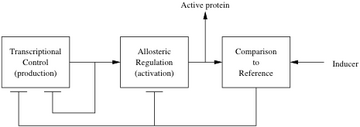Biomolecular Feedback Circuits for Modular, Robust and Rapid Response
This is a joint project with Steve Mayo, funded by the ARO Institute for Collaborative Biotechnologies.
Project participants:
|
Collaborators
|
* partial funding
Objectives
We are working to develop a new class of feedback circuits that makes use of synthetic biological components to implement rapid response to input signals in a more robust and modular fashion. Our approach is to make use of biological processes that operate on timescales of seconds to minutes, primarily through feedback mechanisms using allosteric and covalent modifications that affect protein function. We are exploring the use of the modularity of protein domains to design circuit elements that can be reused more easily than existing components, and we will test our circuits across a variety of cellular contexts to assess robustness as a fundamental property of the design.
Specific objectives for this project include:
- Exploration of RNA-based mechanisms for regulating protein expression
- Develop and characterize a set of programmable covalent modifications that modulate protein activity
- Design, synthesize and test a circuit that uses multiple, heterogeneous feedback mechanisms for regulation of gene activity
References
None to date
- Design and Implementation of a Biomolecular Circuit for Tracking Protein Concentration, Emmanuel L. C. de los Santos, Victoria Hsiao and Richard M. Murray. 2013 American Control Conference (ACC).
- Performance Metrics for a Biomolecular Step Response, Shaunak Sen and Richard M. Murray. Conference on Decision and Control (CDC), 2012.
- CAGEN Robust Gene Response Challenge
This research is supported by the Institute for Collaborative Biotechnologies through grant W911NF-09-0001 from the U.S. Army Research Office. The content of the information does not necessarily reflect the position or the policy of the Government, and no official endorsement should be inferred.
|
|
|
